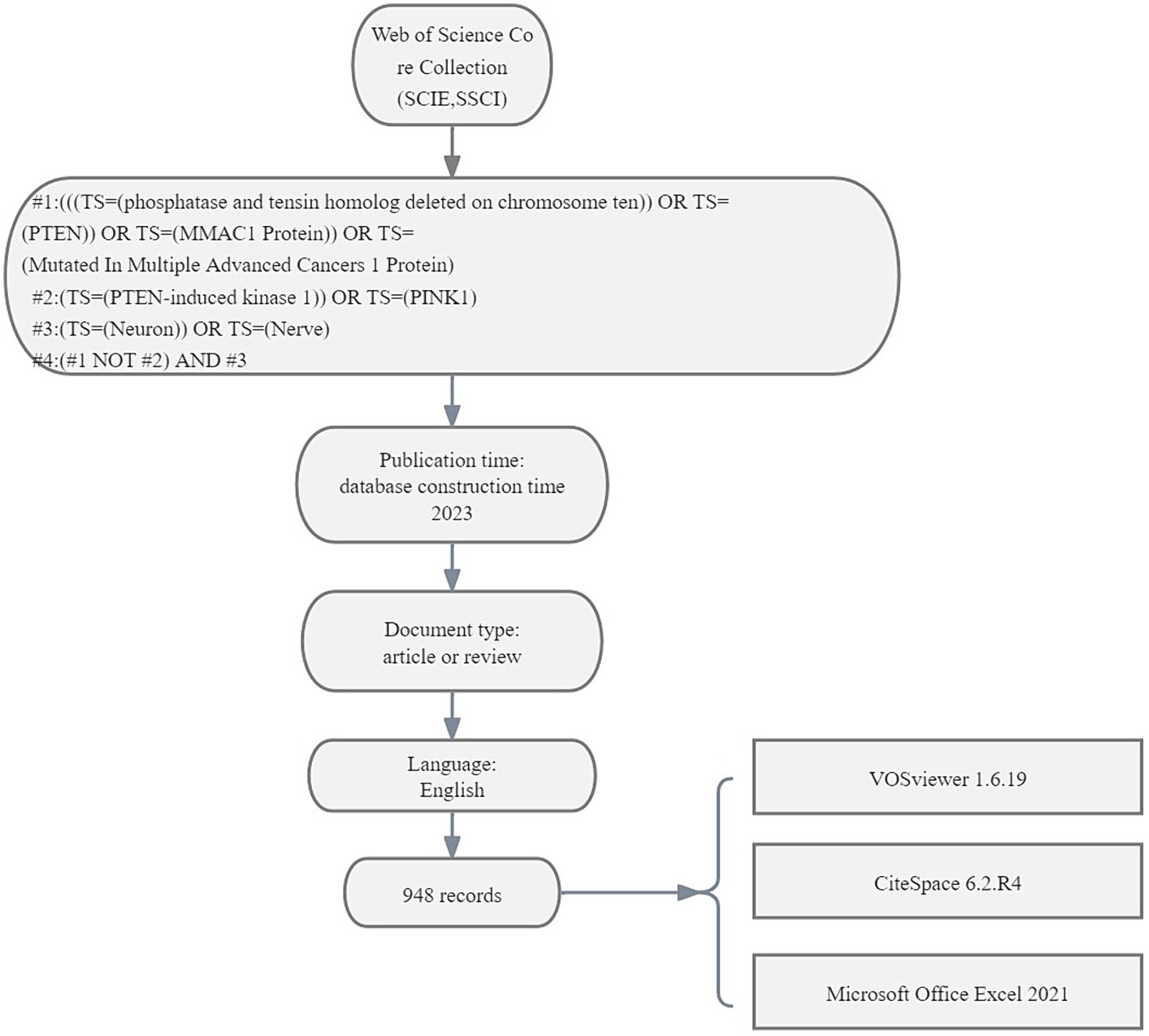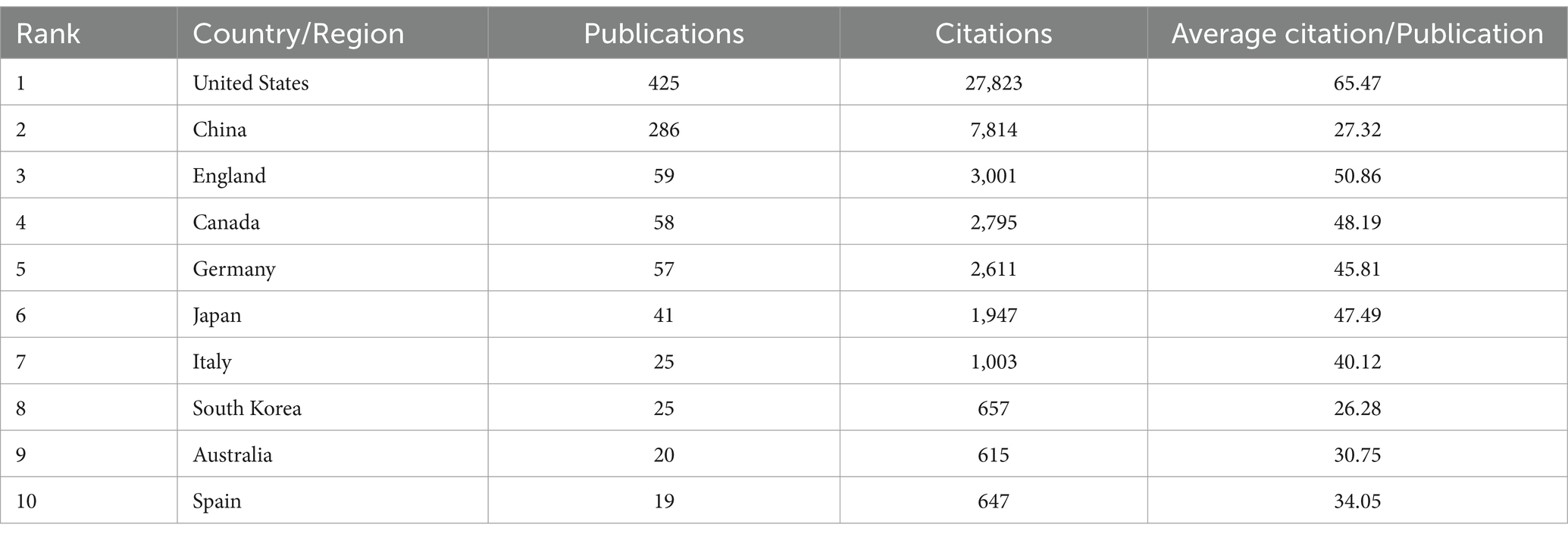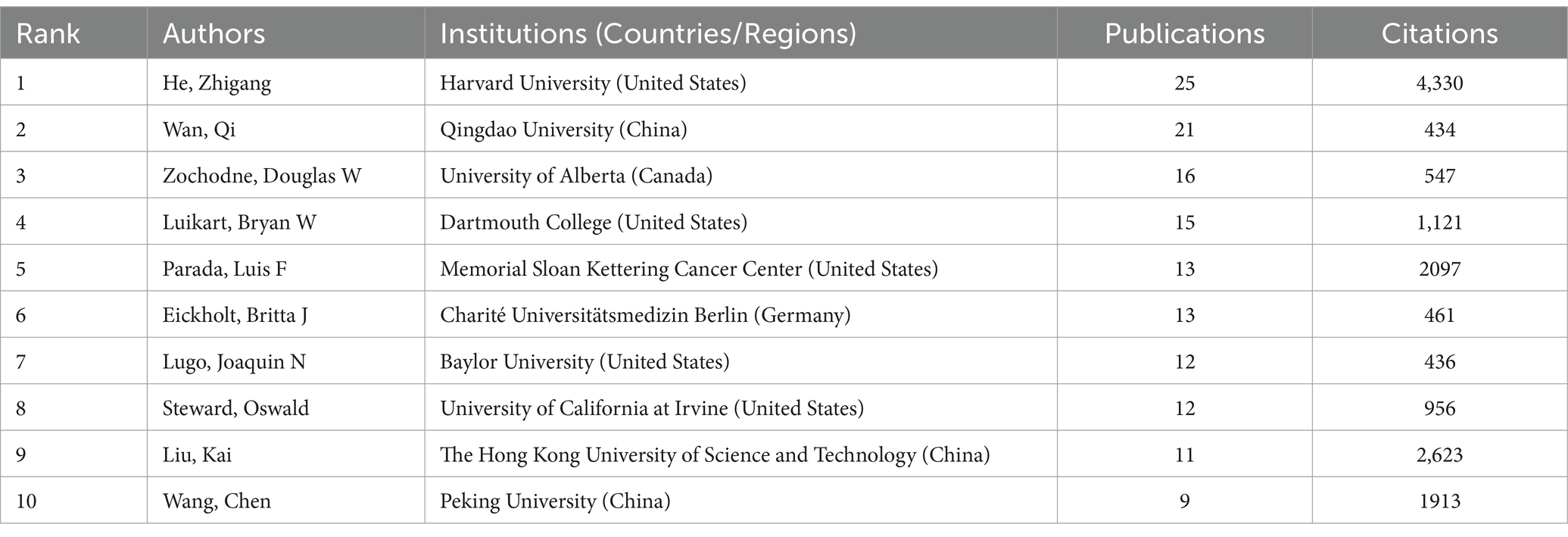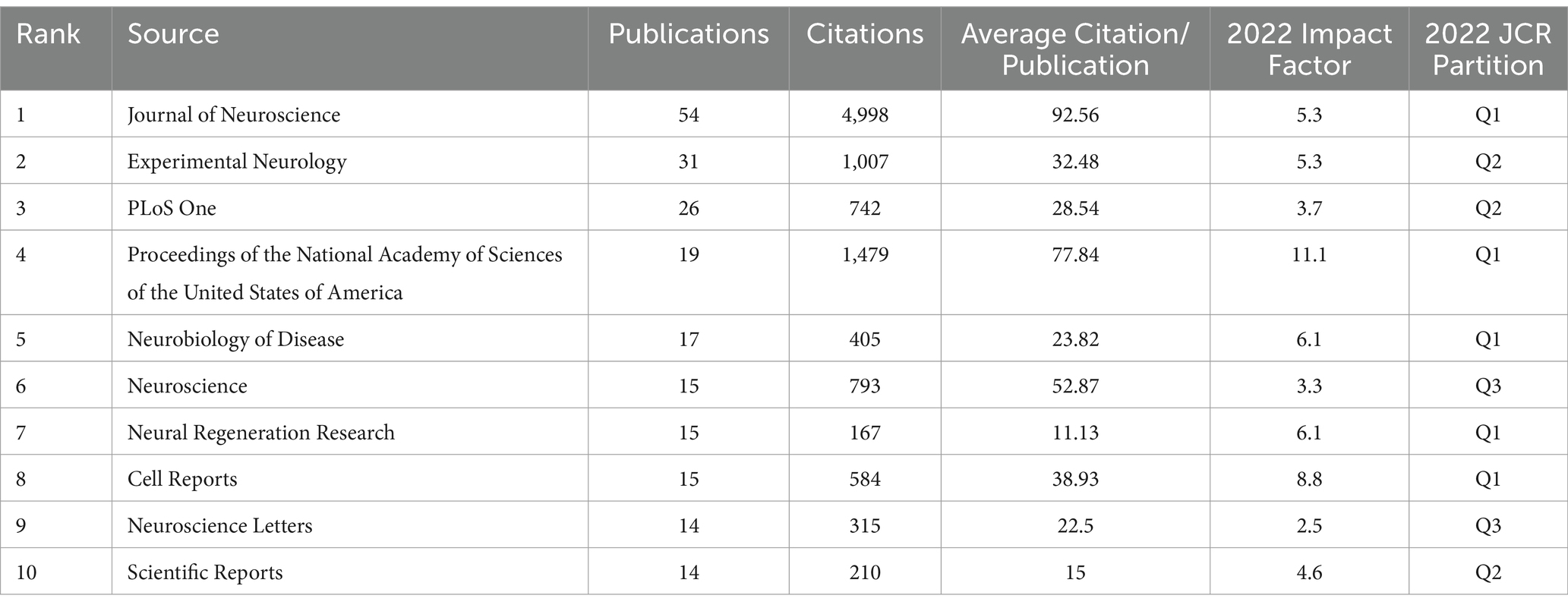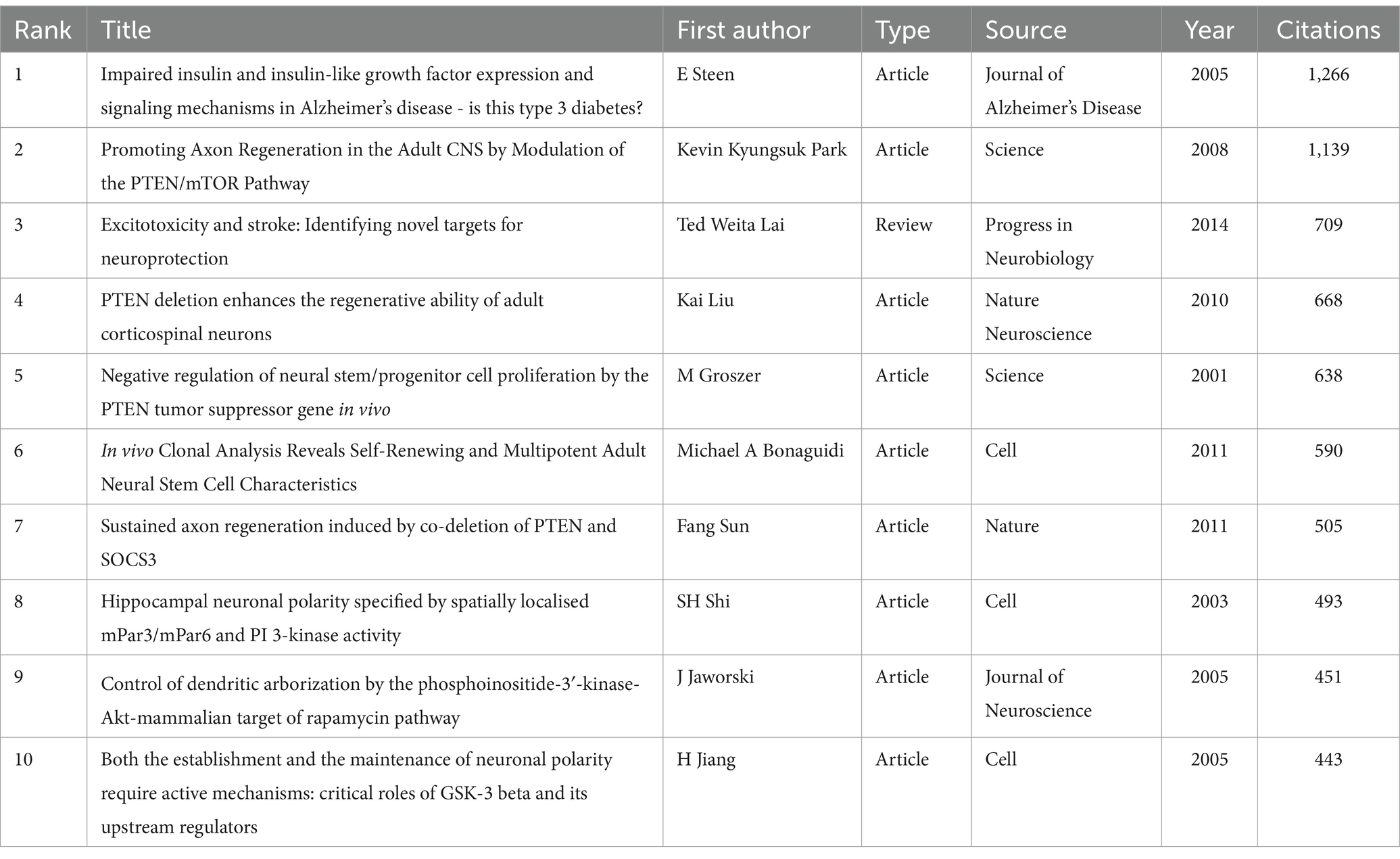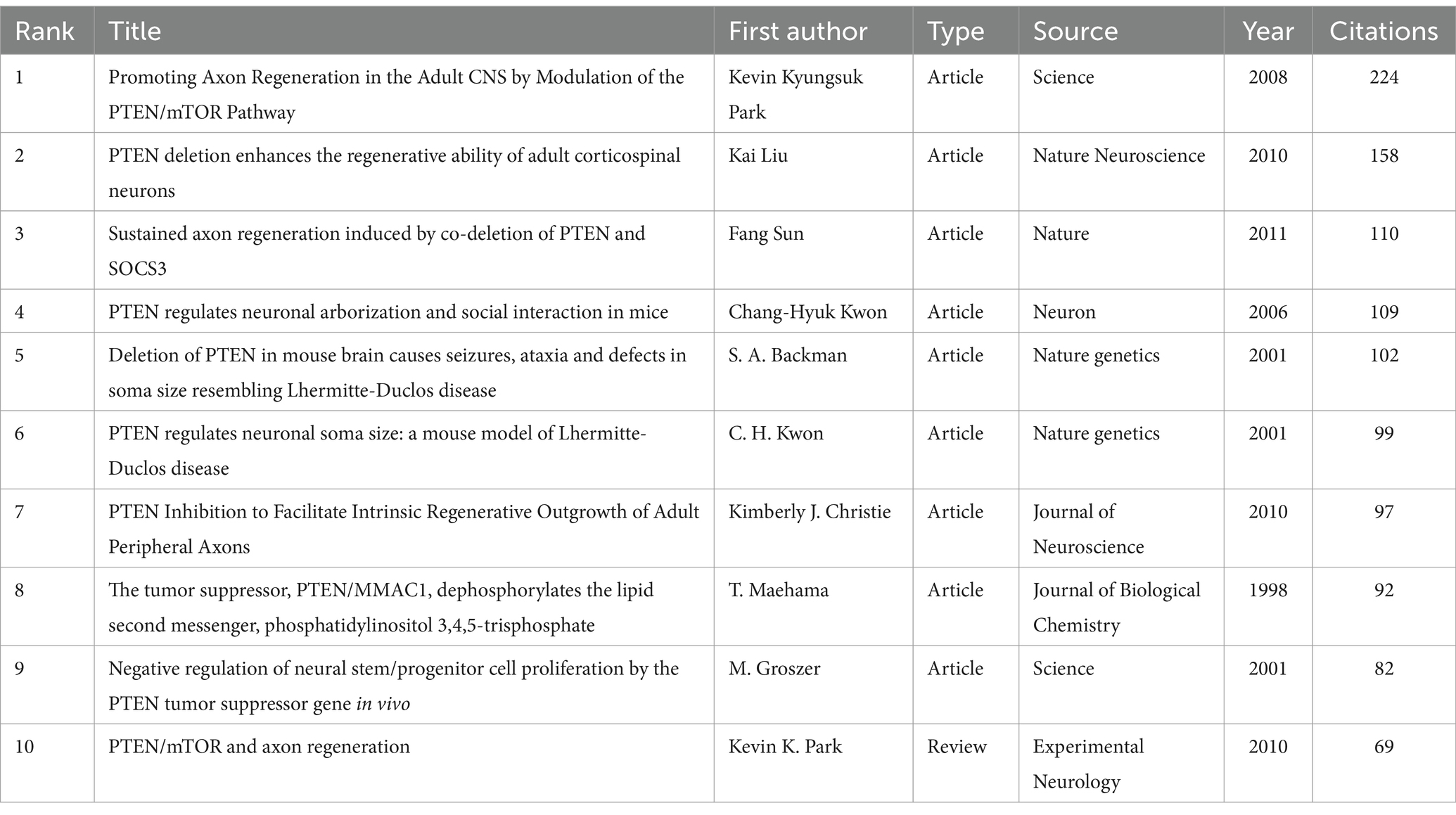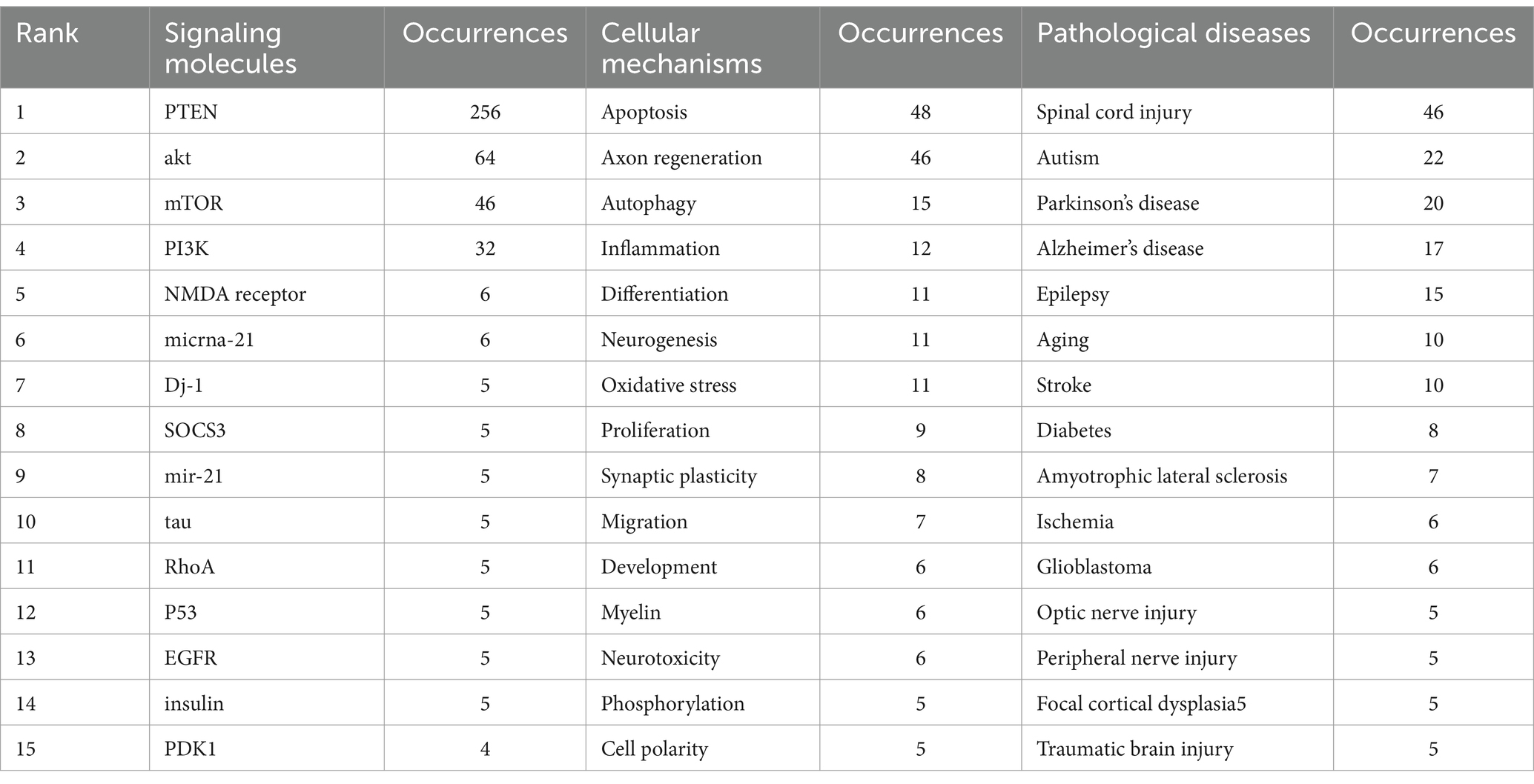Bibliometric analysis of PTEN in neurodevelopment and neurodegeneration
- 1Department of Anesthesiology, The Second Xiangya Hospital, Central South University, Changsha, Hunan, China
- 2Department of Anatomy and Neurobiology, School of Basic Medical Sciences, Central South University, Changsha, Hunan, China
- 3Medical Imaging Center, Qingdao West Coast New District People's Hospital, Qingdao, Shandong, China
- 4Department of Pathology, The Second Xiangya Hospital, Central South University, Changsha, Hunan, China
- 5Center for Medical Research, The Second Xiangya Hospital, Central South University, Changsha, Hunan, China
Phosphatase and tensin homologue deleted on chromosome ten (PTEN) was initially recognized as a significant regulator of cancer suppression and could impede cancer cell survival, proliferation, and energy metabolism. PTEN is highly expressed in neurons and performs crucial functions in neurogenesis, synaptogenesis, and neuronal survival. Disruption of PTEN activity may also result in abnormal neuronal function and is associated with various neurological disorders, including stroke, seizures, and autism. Although several studies have shown that PTEN is involved in the development and degenerative processes of the nervous system, there is still a lack of in-depth studies that summarize and analyse patterns of cooperation between authors, institutions, countries, and journals, as well as research hotspots and trends in this important field. To identify and further visualize the cooperation and comprehend the development and trends of PTEN in the nervous system, especially in neural development and neurological diseases, we used a bibliometric analysis to identify relevant publications on this topic. We first found that the number of publications displayed a growing trend with time, but this was not stable. Universities, institutions, and authors from the United States are leading in this area of research. In addition, many cutting-edge research results have been discovered, such as key regulatory molecules and cellular mechanisms of PTEN in the nervous system, which may provide novel intervention targets and precise therapeutic strategies for related pathological injuries and diseases. Finally, the literature published within the last 5 years is discussed to identify future research trends regarding PTEN in the nervous system. Taken together, our findings, analysed using bibliometrics, may reflect research hotspots and trends, providing a reference for studying PTEN in the nervous system, especially in neural development and neurological diseases. These findings can assist new researchers in developing their research interests and gaining basic information. Moreover, our findings also may provide precise clinical guidelines and strategies for treating nervous system injuries and diseases caused by PTEN dysfunction.
1 Introduction
The phosphatase and tensin homologue deleted on chromosome ten (PTEN) was initially recognized as a significant regulator of cancer suppression by inhibiting the activation of the phosphoinositide 3-kinase (PI3K) molecular pathway, which can impede tumour cell survival, proliferation, and energy metabolism (Luo et al., 2021; Xu J et al., 2021; Blanco et al., 2022). PTEN contains a phosphatase domain at the N-terminus and a C2 domain that binds to the plasma membrane (Campbell et al., 2003). PTEN is both a protein and lipid phosphatase that dephosphorylates serine, tyrosine, and threonine residues on several protein substrates (Hopkins et al., 2018; Hu et al., 2019). Because of PTEN’s phosphatase-dependent function of PTEN, the PI3K-AKT pathway is potently inhibited and disturbs various cellular processes, such as DNA replication, cycle progression, and proliferation (Lunardi et al., 2015; Mathur et al., 2017; Ban et al., 2024). Over the past two decades, researchers have revealed that PTEN plays an essential role both in the normal development of organisms and tumorigenesis (Knobbe et al., 2008; Christine et al., 2022). PTEN has also been found to be highly expressed in neurons and performs crucial functions in neurogenesis, synaptogenesis, and neuronal survival (Wong et al., 2018; Wang et al., 2019; Spina Nagy et al., 2021). Disruption of PTEN activity may also result in abnormal neuronal function and is linked to various neurological disorders, including strokes, seizures, and autism (Chen et al., 2019; Cullen et al., 2023; Fan et al., 2023). For example, a comprehensive library of pathology-associated PTEN mutations was generated by collecting exome and genome sequences from patients with autism, confirming its role as a risk factor for nervous system diseases (Wu et al., 2020). Furthermore, suppressing PTEN is widely regarded as a compelling approach to enhance axon regeneration in impaired or deteriorating neuronal axons (Lu et al., 2014; Nieuwenhuis and Eva, 2022). In accordance with accumulating evidence that PTEN is widely involved in the development and degenerative processes of the nervous system, developing a deeper understanding of the hotspots and trends of PTEN research, especially in neural development and pathological diseases, would assist researchers in understanding the most fundamental, novel, and influential research results, as well as helping new researchers to select potential and valuable research directions.
Review and bibliometrics are two types of study that are useful for summarising and analysing literature in a specific research area (Hu et al., 2022; Zhu et al., 2022; Liu et al., 2023). Compared with reviews, bibliometric analyses, which use mathematical and statistical methods, can evaluate publication quality, citation burst, and scholarly impact, thereby reflecting the current state of related research information (Chen et al., 2020; Shah et al., 2021; Creager et al., 2022; Zhang JH et al., 2023). This discipline can also provide new researchers who aim to enter the field of research with the most fundamental and influential research studies (Yan et al., 2022; Zhang et al., 2022). CiteSpace and VOSviewer are two popular visual software packages for analysis that can help bibliometric researchers arrange large quantities of disordered data into an objective and rigorous network diagram (Yan et al., 2021; Wang and Maniruzzaman, 2022; Zheng et al., 2022). Based on these bibliometric sets, the research results may answer the following questions: What is the pattern of cooperation among authors, institutions, countries, and journals (Halepoto et al., 2022; Pan et al., 2022; Melo et al., 2023)? What is the most influential research topic in a specific field (Halepoto et al., 2022; Pan et al., 2022; Melo et al., 2023)? What are the current research hotspots in the published literature? What might be the future research trends in this specific field (Halepoto et al., 2022; Pan et al., 2022; Melo et al., 2023)?
In this bibliometric analysis, we provide a comprehensive overview of the role of PTEN in the nervous system, particularly in neural development and neurological diseases. First, we determined the distribution and frequency of related publications and citations. Additionally, we reviewed the most influential research results and achievements associated with PTEN in the nervous system. These results can help new researchers develop their research interests and gain basic information. Moreover, our findings may provide precise clinical guidelines and strategies for treating nervous system injuries and diseases caused by PTEN dysfunction.
2 Data and methods
2.1 Data strategy and screening criteria
We first retrieved similar keywords in MeSH Database1 and the Web of Science Core Collection (WoSCC) following the retrieved formula: #1: (((TS = (phosphatase and tensin homolog deleted on chromosome ten)) OR TS = (PTEN)) OR TS = (MMAC1 Protein)) OR TS = (Mutated In Multiple Advanced Cancers 1 Protein); #2:(TS = (PTEN-induced kinase 1)) OR TS = (PINK1); #3:(TS = (Neuron)) OR TS = (Nerve); #4:(#1 NOT #2) AND #3.
We retrieved the literature from 1999 to 2023 and selected those listed as ‘Article’ and ‘Review,’ excluding letters, materials, books, corrections, and retracted literature. Next, two authors independently screened the literature based on the titles and abstracts to exclude studies unrelated to the topic of interest. This exclusion criterion was mainly used to limit the range of the authors, cited references, and keywords (Xu G et al., 2021; de Oliveira et al., 2023). If necessary, the authors read the full text to further screen for appropriate literature and discuss different views (Xu G et al., 2021; Wang et al., 2023). Finally, we obtained and analysed 948 documents. All the records of the retrieved files were downloaded and saved in text form (Figure 1). This retrieval was completed on 23 January 2024.
2.2 Methodology
Bibliometric analysis is a data analysis method that uses CiteSpace and VOSviewer, which applies artificial intelligence, mathematics, and statistics to study the change patterns, quantitative relationships, and distribution structure of the literature (Wang and Maniruzzaman, 2022; Guo J et al., 2023). The bibliometric research results include, but are not limited to, the publication year, authors, institutions, countries, journals, cited references, and keywords (Wang and Maniruzzaman, 2022; van den Hoven et al., 2023). All retrieved and downloaded information was collated into VOSviewer and CiteSpace for scientific mapping and visualization (Zhang T et al., 2023).
Using CiteSpace, citations can be visualized by focusing on potential scientific areas (Zhu et al., 2021; Albuquerque et al., 2022). The software is based on scientific metrics and information visualization. It can draw and visualize a co-occurrence map of cooperation among authors, institutions, and countries with top citations and keyword clustering (Peng et al., 2022; Tan et al., 2023). Using VOSviewer, we constructed bibliometric networks based on authors, journals, and individual publications (Tan et al., 2023). It was also used to visualize and analyse the co-occurrence networks of key research terms, ultimately allowing us to gain a comprehensive understanding of the development of the research area (Albuquerque et al., 2022; Peng et al., 2022). Finally, the number of publications and published information (Figure 2) were analysed and drew using Microsoft Office Excel.
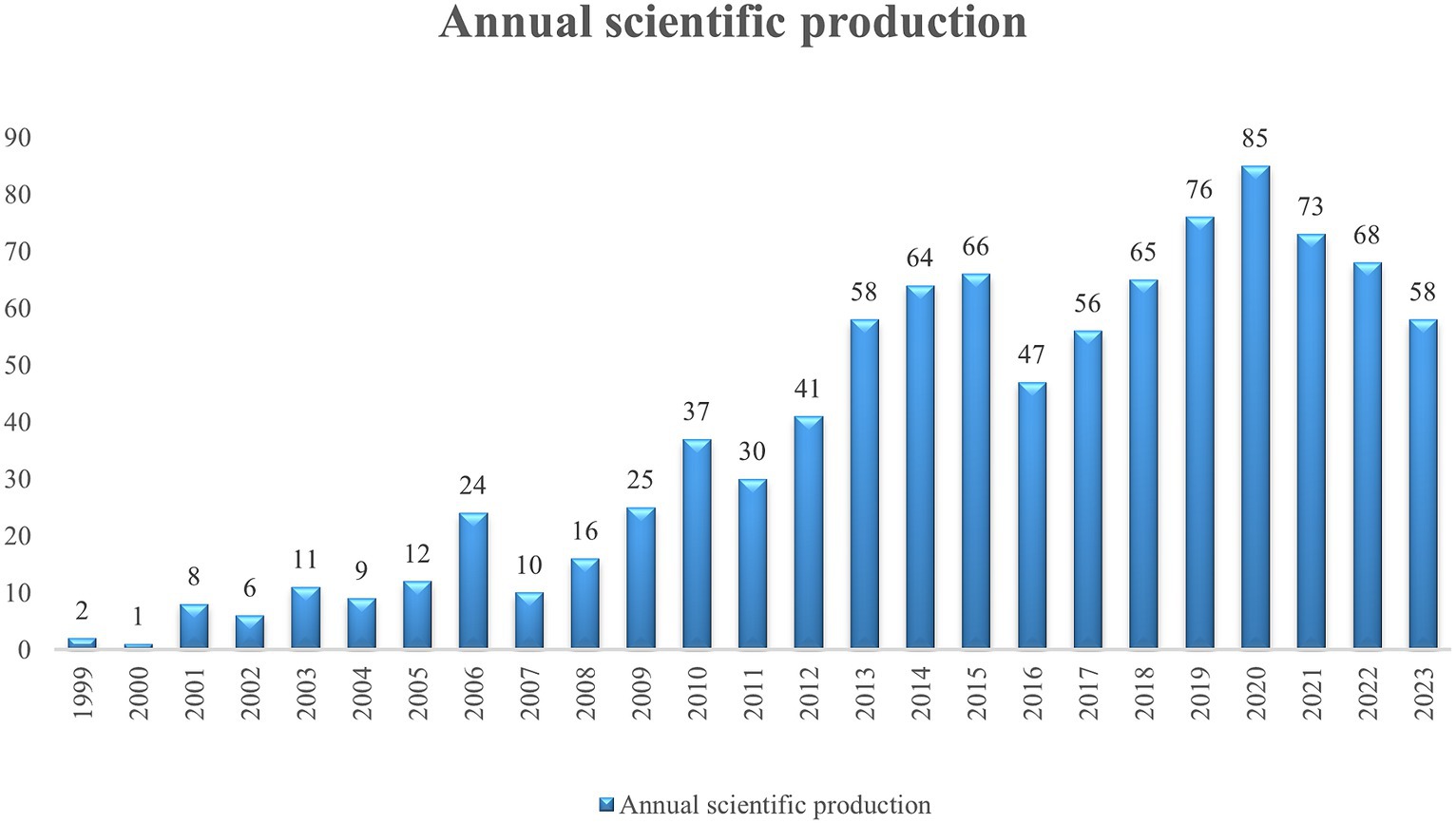
Figure 2. Publication outputs over the years on PTEN in the nervous system. The literature numbers showed an increasing but unstable trend.
3 Results
3.1 Publication outputs
To evaluate the research progress in the field of PTEN in the nervous system, we retrieved the publication outputs of 881 studies from the WoSCC over the years (Figure 2). Overall, the literature shows an increasing but unstable trend. From 1999 (n = 2), the number of studies increased and peaked in 2006 (n = 24), but declined in 2007 (n = 10). From 2007, the number of studies increased again and peaked in 2015 (n = 66) but declined in 2016 (n = 47). Finally, from 2016, the number of studies increased and peaked in 2020 (n = 85) but decreased annually from 2020. Nonetheless, the overall increasing trend suggests that research on PTEN expression in the nervous system has drawn increasing attention in recent years.
3.2 Distribution of studies by country or region
Forty-seven countries/regions had contributed to the study of PTEN in the nervous system (Figure 3A). The top 10 countries/regions that published the most studies are shown in Table 1, including the United States (n = 425), China (n = 286), England (n = 59), Canada (n = 58), and Germany (n = 57). Although China has ranked among the top two productive countries, the total and average citations are lower compared with other countries/regions with fewer studies (Figure 3A; Table 1). A strong burst of citations can be reflected in changes over a short period. The country with the highest burst strength was China (10.43), followed by Japan (4.36) (Figure 3B), indicating that many researchers from China and Japan are devoted to studying PTEN in the nervous system.
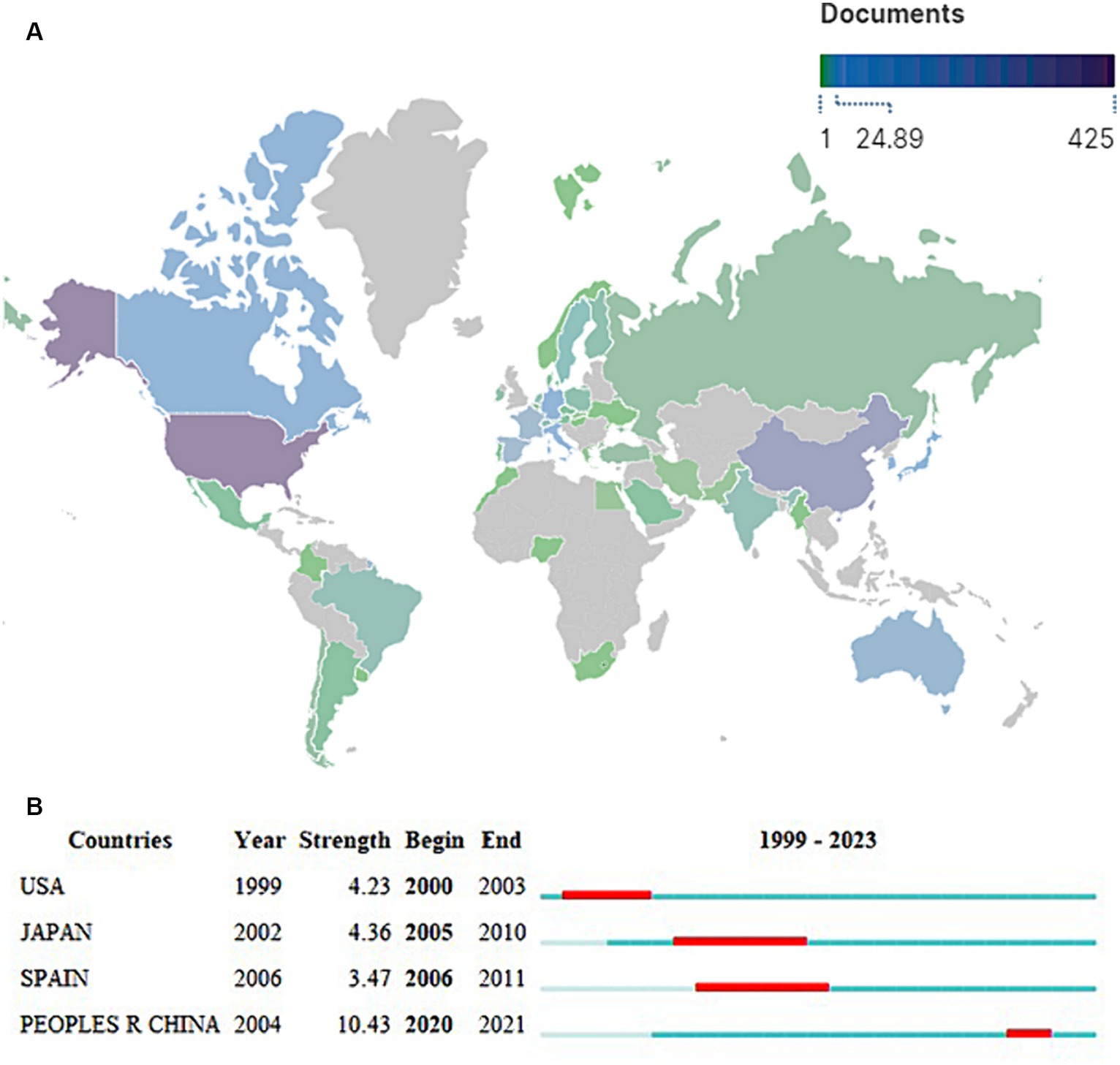
Figure 3. Distribution of studies by countries or regions. (A) Word map of the spatial distribution of the literature. The number of studies is indicated by distinct colors, while grey represents no publications from that country. The United States published the most studies with the highest number of citations. (B) The top four countries with the strongest citation bursts. The red bars represent citation burst durations.
3.3 Co-authorship of institutions
A total of 1,037 institutions contributed to research on PTEN in the nervous system. The top seven institutions that published the most literature are labelled in Figure 4, including the University of California System (55 documents), Harvard University (54 documents), Boston Children’s Hospital (35 documents), Pennsylvania State System of Higher Education (20 documents), Johns Hopkins University (18 documents), the University of Texas System (15 documents), and Balor College of Medicine (15 documents), indicating that the most influential institutions in the field are from the United States. We also visualized the institutions with more than five studies (Figure 4). The partnership network results showed that all the most prolific institutions were from the United States, indicating that those institutions may make up the core of research in this field. Of note, the only non-American institutions among the top 10 were Shanghai Jiao Tong University, Nantong University of China, and the University of London of England, indicating that institutions from other countries/regions should strengthen their cooperation with other institutions (Figure 4).
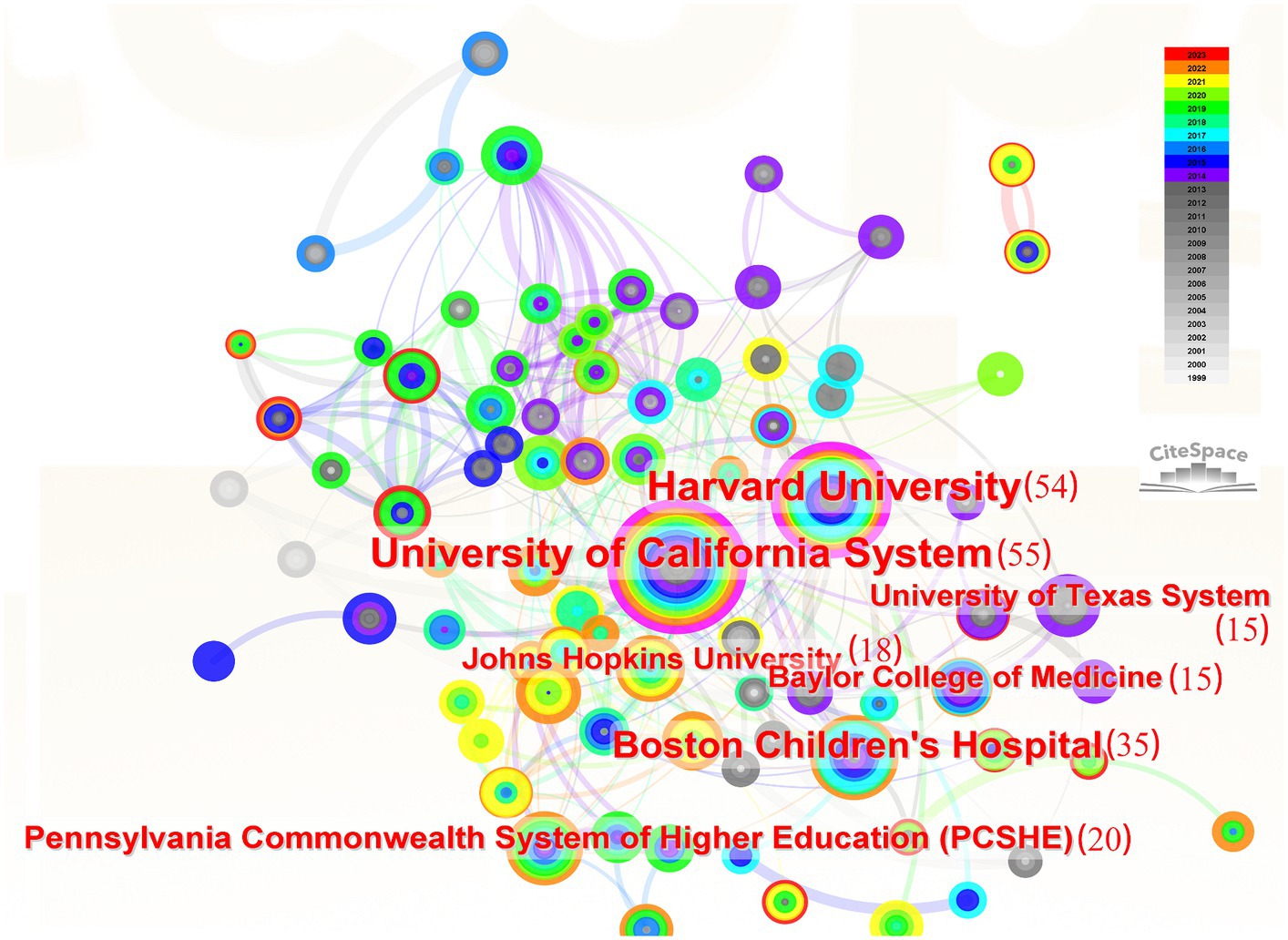
Figure 4. Co-authorship of institutions. The most prolific institutions, which collaborate more with others, are from the United States. The numbers of studies are in brackets. The width of the line indicates the strength of the relationship.
3.4 Co-authorship of authors
A total of 5,398 authors participated in research on PTEN in the nervous system. The top 10 authors who published the greatest quantity of studies are listed in Table 2. Half of the top 10 authors were from the United States, indicating that these authors might have the greatest influence in the related field. Zhigang He (22 documents), from Harvard University, is the most prolific author, who is mainly devoted to investigating effective and translatable axon regeneration methods for nervous injuries (Cartoni et al., 2017; Norsworthy et al., 2017; Jacobi et al., 2022), indicating that research on PTEN in axon regeneration is a hot research topic. Qi Wan (21 documents) is a specialist leading in the research of PTEN-mediated neuronal death from Qingdao University and worked at the Toronto Western Research Institute (Ning et al., 2004; Liu B et al., 2010; Kong et al., 2022). Prof. Wan revealed a series of comprehensive neuroprotective mechanisms mediated by PTEN-related pathways in brain injuries and neurodegenerative diseases, making PTEN-mediated neuronal death another popular research topic (Chang et al., 2007; Hu et al., 2023; Kong et al., 2023). Next, we set the threshold to four studies and analysed the authors who met the criteria (Figure 5). In the visualized map, the lines between the nodes indicate collaboration among authors. Overall, there are 11 color clusters, of which the top three are centred on Zhigang He, Qi Wan, and Douglas W. Zochodne, indicating that they are the most influential authors in this research area. However, there were almost no connections among the different clusters, indicating that the authors collaborated very little in the different sub-research areas.
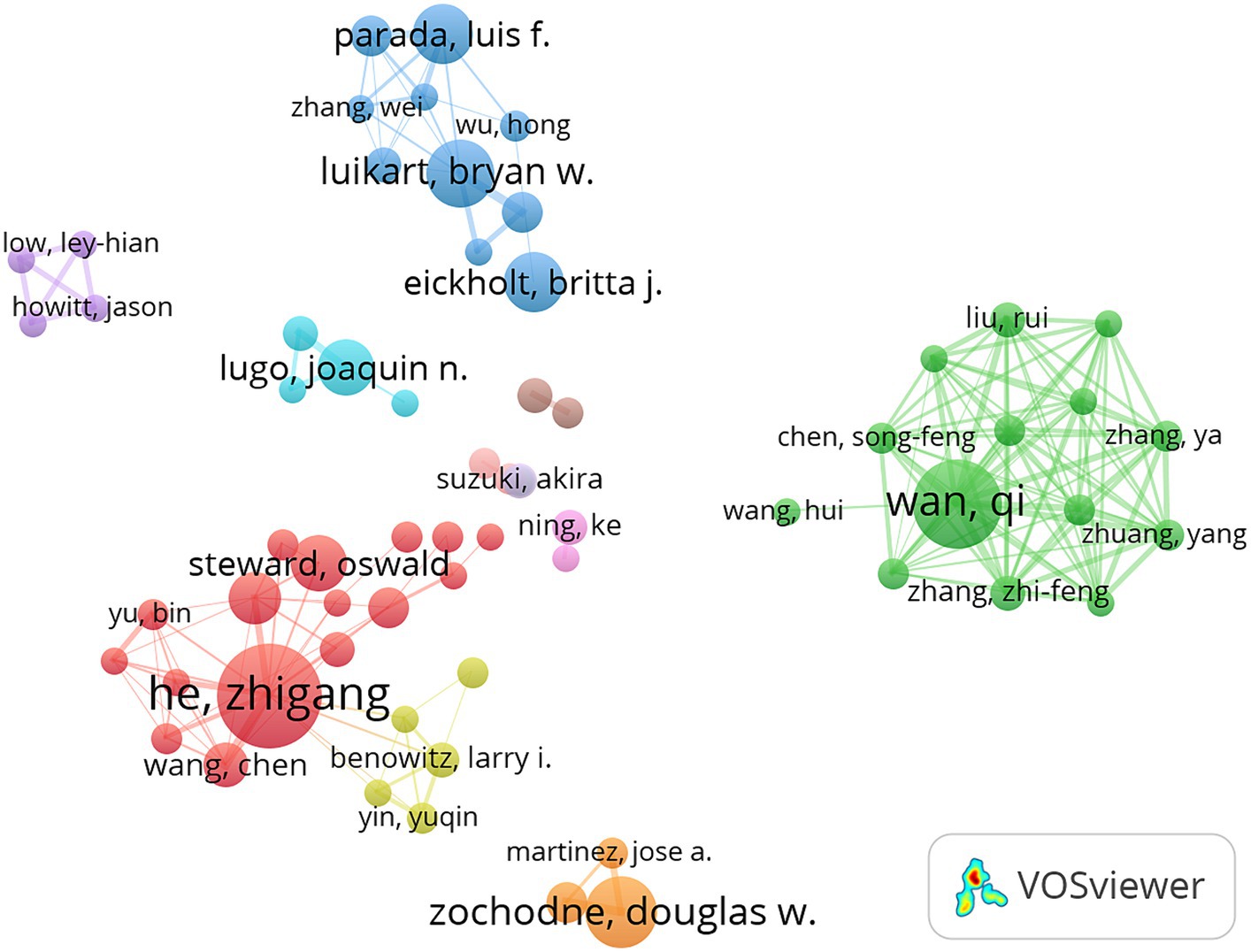
Figure 5. Co-authorship of authors. Half of the top 10 authors are from the United States. The lines between the nodes indicate collaborations among the authors. The line widths indicate the strength of the relationship.
3.5 Density visualization of journals
Literature on PTEN in the nervous system has been published in 337 journals. By analysing journals that published more than five articles, we found that the Journal of Neuroscience was the top journal publishing on this topic and had the highest total and average citations, making it the most influential journal in this research field (Table 3). Our results also indicate that the top 10 journals with the highest impact factor in 2021 ranged from 2.5 to 11.1, and Proceedings of the National Academy of Sciences of the United States of America (PNAS) had the highest impact factor.
3.6 Co-authorship of top-cited literature and co-citation analysis
Literature cited more than 10 times was analysed and is listed (Figure 6A; Table 4). These findings may indicate the most influential studies associated with PTEN in the nervous system. Among them, ‘Impaired insulin and insulin-like growth factor expression and signaling mechanisms in Alzheimer’s disease - is this type 3 diabetes?’ (Steen et al., 2005), published in Journal of Alzheimer’s Disease in 2005, has been most cited (1,266 Citations), followed by ‘Promoting Axon Regeneration in the Adult CNS by Modulation of the PTEN/mTOR Pathway’ (Park et al., 2008), published in Science in 2008 (1,139 Citations), and ‘PTEN deletion enhances the regenerative ability of adult corticospinal neurons’ (Liu K et al., 2010), published in Nature Neuroscience in 2010 (668 Citations). Besides, ‘Excitotoxicity and stroke: Identifying novel targets for neuroprotection’ (Lai et al., 2014), published in Progress in Neurobiology in 2014, is the most cited review (709 Citations).

Figure 6. Co-authorship of top-cited literature and co-citation analysis. (A) Studies that have been cited more than 10 times. (B) The top 10 co-cited references. The same color clusters indicate the documents are related or have some commonalities. The lines between the nodes indicate the connections among the documents. The top three co-cited references are also involved in the top 10 cited studies.
We further visualized the co-cited references and listed the top ten articles using VOSviewer (Figure 6B; Table 5), which can indicate the core references cited by other studies in the same research area. ‘Promoting Axon Regeneration in the Adult CNS by Modulation of the PTEN/mTOR Pathway’ has the most citations (224 Citations) (Park et al., 2008), followed by ‘PTEN deletion enhances the regenerative ability of adult corticospinal neurons’ and ‘Sustained axon regeneration induced by co-deletion of PTEN and SOCS3’ (Liu K et al., 2010). Of note, the top three co-cited references were also included in the top ten cited studies, indicating that they are also the most influential studies in the research field.
3.7 The analysis of the current research hotpots
The top-cited keywords over the years indicate the current research trends in the research area. In this section, we visualized keywords with more than five articles (Figure 7A). Keywords such as PTEN (256 times), Akt (64 times), mTOR (46 times), axon regeneration (46 times), and spinal cord injury (46 times) appeared to be cited most frequently, indicating current research hotspots (Figure 7A).
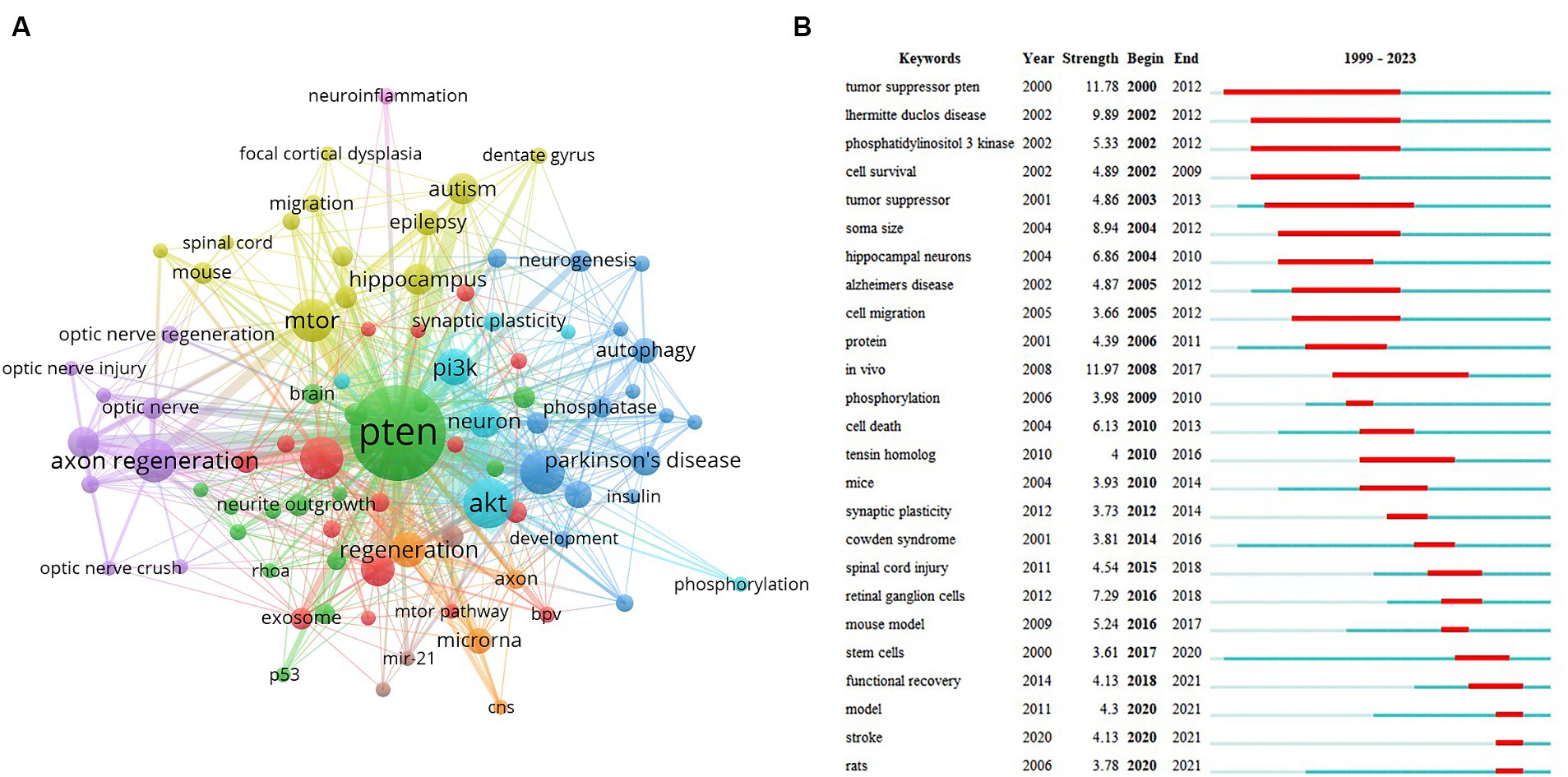
Figure 7. Analysis of the current research hotspots. (A) Top cited keywords with more than five studies. The circle size indicates the frequency. The width of the line indicates the strength of the relationship. (B) Top 25 keywords with the strongest citation bursts. The red bars represent citation burst durations.
Citation explosion, indicated by cited burst strength, refers to the rapid increase in the number of cited keywords in a brief period. This indicates that keywords have drawn significant attention in this field during this period. The top 25 keywords with the highest cited burst strengths were further analysed (Figure 7B). ‘In vivo’ had the strongest burst strength of 11.97 (Figure 7B), suggesting that ‘in vivo’ study about PTEN in the nervous system is the key hotspot. In addition, nervous system diseases include Lhermitte–Duclos disease, Alzheimer’s disease (AD), spinal cord injury (SCI), and stroke. Cellular mechanisms, such as cell death, migration, and synaptic plasticity, which have strong burst strength, also occurred in the top 25 keywords (Figures 7A,B), suggesting that they are also key research hotspots.
Finally, we specifically analysed the primary molecules involved in the research on PTEN in the nervous system, which could suggest the key regulated pathways involved in the related research area. The top 15 molecules with the highest frequencies are listed in Table 6, mainly covering PTEN (256 times), Akt (64 times), mTOR (46 times), PI3K (32 times), and NMDA receptor (6 times). We also listed the most frequently occurring cellular mechanisms, including apoptosis (48 times), axon regeneration (46 times), autophagy (15 times), inflammation (12 times), and differentiation, neurogenesis, and oxidative stress (11 times each). These results suggest that cellular mechanisms have attracted considerable attention as a potential research hotspot. Table 6 lists the pathological diseases involving the study of PTEN in the nervous system. The 15 most frequently occurring diseases were SCI (46 times), autism (22 times), Parkinson’s disease (PD) (20 times), AD (17 times), and epilepsy (15 times), which are the most common diseases studied in relation to PTEN involvement in the nervous system.
3.8 The analysis of the future research trends
Analysing the publication trends of PTEN in the nervous system published within the last 5 years could allow further extrapolation of the future trends of PTEN research. Therefore, we visualized and listed the top emerging research keywords with more than five articles, including those regarding signaling molecules, cellular mechanisms, and diseases (Figure 8). The frequency figures are labelled in Figure 8, mainly covering the signaling molecules, such as akt (21 times), PI3K (13 times), and mTOR (13 times), the cellular mechanisms, such as apoptosis (18 times), axon regeneration (18 times) and inflammation (7 times), and diseases including spinal cord injury (20 times), Parkinson’s disease (7 times) and autism (7 times), which may be hotspots and targets of further research trends on the study of PTEN in the nervous system.
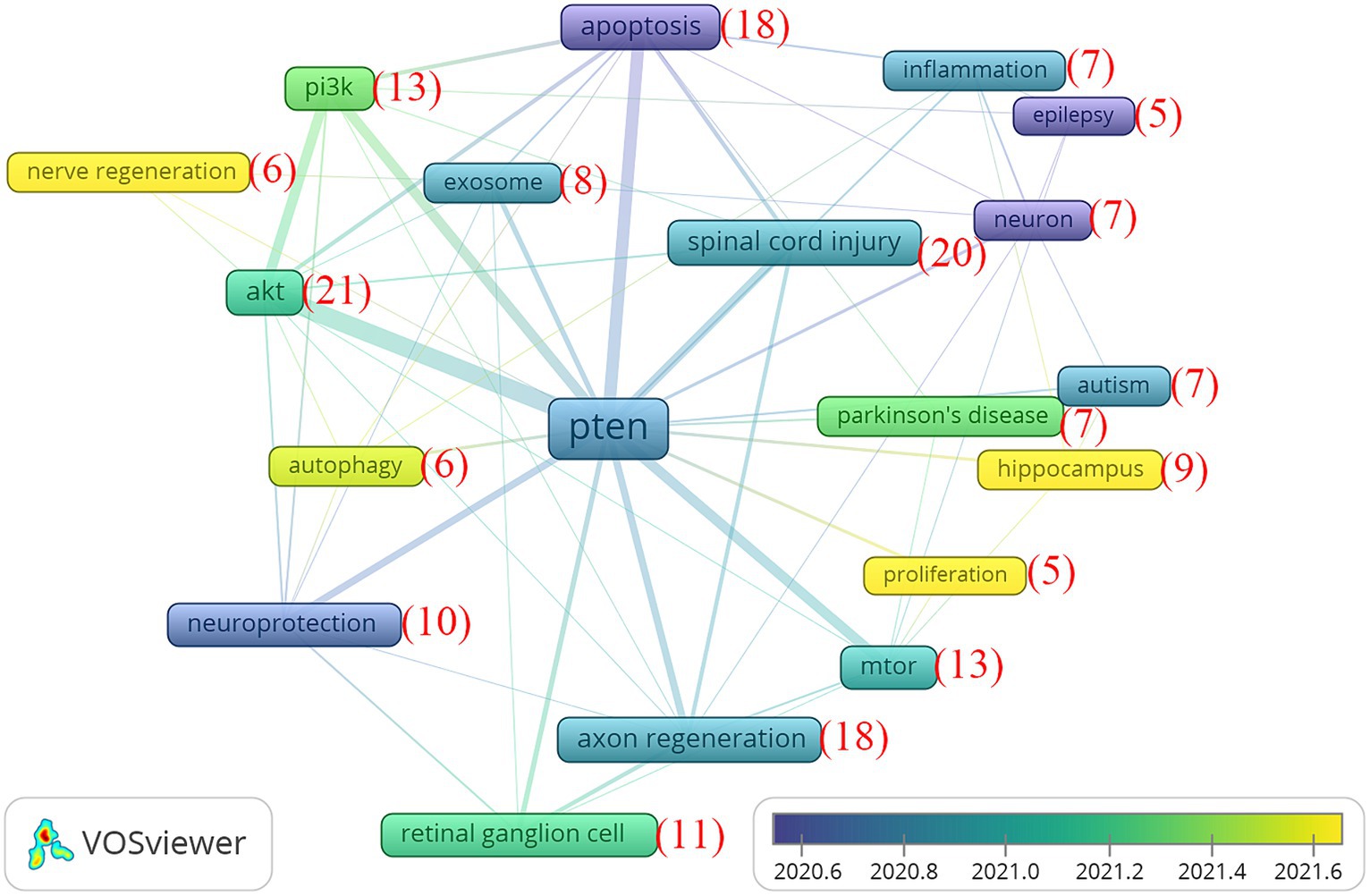
Figure 8. Analysis of the future research trends. Top cited keywords with more than five studies published in 5 years. The numbers of citations are in brackets. The width of the line indicates the strength of the relationship.
3.9 An overview of signaling molecules, cellular mechanisms, and pathological diseases
In this section, we review the key signaling molecules, cellular mechanisms, and pathological diseases involved in research on PTEN and the nervous system (Figure 9). Many studies have indicated that PTEN is the main antagonist of PI3K/Akt signaling by dephosphorylating PIP3 to PIP2 (Li et al., 2021; Nguyen Huu et al., 2021). PIP3 activation after PTEN inhibition could then activate Akt, which is the most prominent PIP3 effector (Li et al., 2021; Dibble et al., 2022). Akt is thought to be the main regulatory molecule involved in cell survival, growth, and proliferation through the phosphorylation and regulation of a series of protein activities (Hoxhaj and Manning, 2020). For example, Akt can phosphorylate and activate the mTOR complex, which promotes protein synthesis and cell proliferation (Li et al., 2013). Akt could also phosphorylate but inactivate glycogen synthase kinase3 (GSK3) (Jiang et al., 2005). This is a vital part of a series of neuronal responses and impairment that occurs by regulating cAMP-response element binding protein (CREB) (Zhou et al., 2014; Zeng et al., 2022), amyloid β-protein (Aβ) (Li et al., 2016; Wani et al., 2019), 1-methyl-4-phenylpyridinium (MPP+) (Guo S et al., 2023; Yu et al., 2023), etc. Besides Akt, PIP3 recruits several GTPase-activating proteins (GAPs) (Shen et al., 2017; Zhu et al., 2019) to the membrane and further activates GTPase families, such as Rac, cdc42, and Arf (Sakakibara and Horwitz, 2006; Zheng et al., 2008; Kilic et al., 2010; Kreis et al., 2014), ultimately modulating cytoskeletal movement and vesicular transport at the membrane, which are important in synaptic potentiation, neurite outgrowth, axon and dendrite specifications, and regeneration (Zheng et al., 2008; Rademacher and Eickholt, 2019; Nieuwenhuis and Eva, 2022). In addition to regulating protein synthesis, the PTEN/PI3K/Akt pathway is important for neuronal survival by regulating BAD/Bcl-2 (Hua et al., 2016). Upstream of PTEN, a neural precursor cell expressing developmentally downregulated protein 4 (NEDD4) functions as an impeder of axon regeneration by catalyzing PTEN ubiquitination and degradation (Dai et al., 2021; Sun et al., 2022).
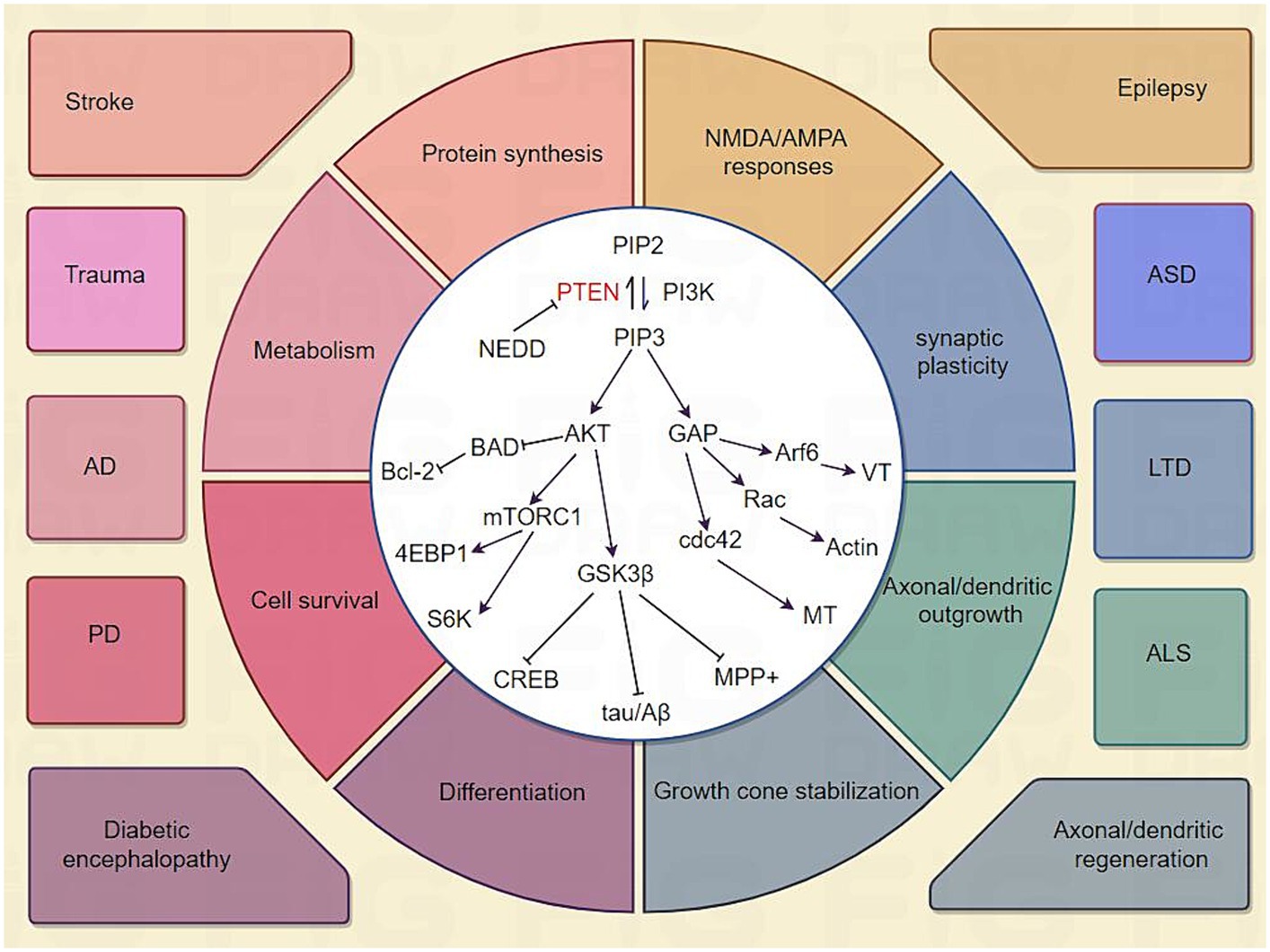
Figure 9. Diagram of the common PTEN and downstream pathways in the nervous system. Canonical PTEN signaling cascade. Activation is depicted with pointed arrows, and inhibition is depicted with flat-headed arrows. PTEN, phosphatase and tensin homolog deleted on chromosome ten; PI3K, phosphoinositide 3-kinase; PIP2, phosphatidylinositol 4,5-bisphosphate; PIP3, phosphatidylinositol 3,4,5-trisphosphate; AKT, protein kinase B; BAD, Bcl2-Associated Agonist Of Cell Death; mTORC1, mammalian target of rapamycin complex 1; Bcl-2, B-cell lymphoma-2; 4EBP1, eIF4E-binding protein; S6K, ribosomal S6 kinase; GSK3, glycogen synthase kinase3; CREB, cAMP-response element binding protein; Aβ, amyloid β-protein; MPP+, 1-methyl-4-phenylpyridinium; GAPs, GTPase activating proteins; cdc42, cell division cycle 42; Arf6, ADP-ribosylation factor 6; MT, microtubule; VT, vesicle trafficking; NEDD4, neural precursor cell expressed developmentally down-regulated protein 4; AD, Alzheimer’s disease; SCI, spinal cord injury and stroke; PD, Parkinson’s disease; ASD, autism spectrum disorders; LTD, long-term depression.
4 Discussion
In this study, we analysed the current hotspots and future trends in the study of PTEN in the nervous system, especially in neural development and pathological diseases, using bibliometrics. We first found that the number of publications tended to grow with time, but it was not stable. Universities, institutions, and authors from the United States are leading researchers in this area. Finally, many cutting-edge research results have been discovered, such as key regulatory molecules and cellular mechanisms of PTEN in the nervous system, which could provide novel intervention targets and precise therapeutic strategies for related injuries and diseases.
4.1 General information
This study retrieved 948 papers published between 1999 and 2023 from WoSCC. Overall, many studies have demonstrated the development and importance of PTEN in the nervous system. Presently, the United States, China, England, Canada, and Germany are in the top five, with the highest number of publications or citations and the strongest influence. Institutions from the United States, such as the University of California System, Harvard University, Boston Children’s Hospital, Pennsylvania State System of Higher Education, and Johns Hopkins University, have published the most documents, indicating that the United States is leading the research and might be the core of research in the world. Additionally, China had the strongest citation bursts in the world, indicating that more researchers in China are devoted to researching the role of PTEN in the nervous system. Regarding journal quality, PNAS had the highest impact factor among journals that have published more than five studies. The Journal of Neuroscience published the most literature and is the most influential journal in this research area.
4.2 High-impact literature
In 2005, Dr. Eric Steen published one article, ‘Impaired insulin and insulin-like growth factor expression and signaling mechanisms in Alzheimer’s disease - is this type 3 diabetes?’ in the Journal of Alzheimer’s Disease, which had the most citations. This study found that deficient energy metabolism and glucose utilization occurred during early AD. They further discussed the impaired insulin signaling in AD, which is accompanied by reduced levels of tau, PI3K, Akt, enhanced glycogen synthase kinase-3β, PTEN, and Aβ production (Steen et al., 2005). Dr. Zhigang He has published 25 papers, making him the leading author in the research on PTEN in the nervous system. The most cited research article from Dr. Zhigang He is ‘Promoting Axon Regeneration in the Adult CNS by Modulation of the PTEN/mTOR Pathway,’ which was published in Science. In this study, they found that there are intrinsic inhibitory molecules impeding axon regeneration and that mTOR activation and protein production were inhibited in crushed retinal ganglion cell (RGC) axons, which may further inhibit axon regrowth. However, the deletion of PTEN in adult RGCs using a conditional knockout approach can robustly facilitate axon regeneration. Thus, their findings provided a manipulated therapeutic method for the intrinsic pathway to enhance axon regrowth after the crushing of axons (Park et al., 2008).
The co-citation map indicates intensive cooperation among researchers interested in the same research area. We found that another two of the top three co-cited references, ‘PTEN deletion enhances the regenerative ability of adult corticospinal neurons’ and ‘Sustained axon regeneration induced by co-deletion of PTEN and SOCS3’, are also involved in the top 10 cited studies. The first study indicates that the PTEN/mTOR pathway is critical for promoting corticospinal tract axon regeneration in injured corticospinal neurons (Liu K et al., 2010). The second study showed that knockout of both PTEN and suppressor of cytokine signaling 3 (SOCS3) cooperatively enhance robust axon regrowth by concurrent activation of mTOR and the Janus kinase (JAK)-signal transducers and activators of transcription (STAT) pathway (Sun et al., 2011). Thus, these highly cited and co-cited articles all proved that targeting intrinsic PTEN is an effective method for enhancing axon regrowth after axonal injury, indicating that it is also a hot topic in the research field.
4.3 Hotspots and frontiers
A keyword frequency analysis was used to reflect the current trends and future directions of a research field. In this study, we found that ‘in vivo’ has the highest burst strength, suggesting that in vivo studies of PTEN in the nervous system are the key hotspot. Some of the most frequent keywords were PTEN, Akt, mTOR, axon regeneration, and spinal cord injury, which are related to signaling molecules, cellular mechanisms, and diseases, suggesting that they are key research hotspots. Notably, the keyword frequency analysis results were consistent with the keywords used in highly cited literature.
To further clarify the specific hotspots in research on PTEN in the nervous system, we first analysed the key signaling molecules related to molecular biology and biochemistry. Except for the key regulators—such as PTEN, Akt, mTOR, and PI3K—exosomes, NMDA receptors, micRNA-21, and DJ-1 also appeared frequently, indicating key signaling molecules and hotspots of PTEN in the nervous system. Furthermore, analysis of the most frequently occurring cellular mechanisms, which mainly include apoptosis, axon regeneration, autophagy, inflammation, and differentiation/neurogenesis/oxidative stress, may provide hotspots for cellular mechanisms that have attracted considerable attention. Statistical analyses of key signaling molecules and cellular mechanisms indicated the importance of PTEN-mediated pathways, mechanisms, and phenotypes in the nervous system. Finally, we analysed the most frequently occurring diseases, mainly SCI, autism, PD, AD, epilepsy, ageing, and stroke, which are hotspot diseases in the study of PTEN involvement in the nervous system and revealed that these diseases attracted more attention among investigators.
Finally, we analysed the publication trends of PTEN in the nervous system published within the last 5 years, which could be used to extrapolate the future trends of PTEN research further. The most frequent keywords, mainly covering signaling molecules, such as Akt, PI3K, and mTOR; cellular mechanisms, such as apoptosis, axon regeneration, and inflammation; and pathological diseases, such as SCI, PD, and autism, suggest research trends in the study of PTEN involvement in the nervous system. However, we failed to analyse further and visualize the trends in potential therapeutics. In our analysis, we carefully screened potential therapeutics and found that no potential therapeutics appeared frequently, which means that no potentially effective or hotpot therapeutics are emerging, and the investigation of effective therapeutics for PTEN-mediated neurodegenerative diseases is urgently needed.
Taken together, a series of studies has suggested that PTEN is a key regulatory molecule in the nervous system, particularly in neural development and pathological diseases. By analysing important signaling molecules and cellular mechanisms, it is important to discover key regulated pathways and provide new therapeutic targets for PTEN-related nervous system injuries and diseases. In addition, discussing the key molecules, mechanisms, and diseases in the research of PTEN in the nervous system could provide wide insight into current research hotspots and could be a reference for new researchers to select their starting research directions. Further research focused on these molecules, mechanisms, or diseases may be gradually discovered, which may also lead to a second spurt of research.
4.4 Limitations
(1) We completed the retrieved work on 23 January 2024. Therefore, some of the latest published literature with key findings may be neglected in this study (Zhu et al., 2021, 2022). (2) We only retrieved articles and reviews from WoSCC because we wanted to guarantee the quality of the literature as much as possible. Therefore, other publication types, like books, case reports, clinical trials, and meta-analyses with important findings, may also be neglected (Peng et al., 2022; Xavier-Santos et al., 2022). (3) Because the search was limited to the WoSCC-indexed journals, a few studies were not included in the WoSCC (Zhu et al., 2022; Gu et al., 2023). (4) Only English studies were retrieved from the WoSCC, so those published in other languages with important research results may not be retrieved and concluded (Peng et al., 2022; Xavier-Santos et al., 2022). (5) Due to software limitations, bibliometric studies are analysed and created by mathematical methods based on machine-driven understanding (Lam et al., 2022; Wang et al., 2022). Therefore, the literature may have included irrelevant documents. Thus, manual and detailed screening and review of the analysed results are needed. These limitations have been reported in other bibliometric studies.
5 Conclusion
This study aimed to analyse research hotspots and trends in PTEN research in the nervous system, particularly in neural development and neurological diseases. Furthermore, a series of key regulated signaling molecules and cellular mechanisms related to PTEN in the nervous system have been identified, which could provide therapeutic targets and guidelines for PTEN-related nervous system diseases in fundamental research and clinical treatments.
Data availability statement
The original contributions presented in the study are included in the article/supplementary material, further inquiries can be directed to the corresponding author.
Author contributions
YZ: Investigation, Methodology, Project administration, Software, Writing – original draft. Y-tT: Formal analysis, Investigation, Methodology, Writing – original draft. M-jW: Investigation, Methodology, Software, Writing – original draft. LL: Data curation, Funding acquisition, Investigation, Methodology, Project administration, Software, Writing – review & editing. J-fH: Project administration, Supervision, Writing – review & editing. S-cW: Conceptualization, Formal analysis, Funding acquisition, Methodology, Project administration, Supervision, Writing – review & editing.
Funding
The author(s) declare financial support was received for the research, authorship, and/or publication of this article. The study was supported by National Natural Science Foundation of China, no. 82101126, Natural Science Foundation of Hunan Province, no. 2021JJ40873, 2022JJ40693, the Scientific Research Launch Project for new employees of the Second Xiangya Hospital of Central South University.
Conflict of interest
The authors declare that the research was conducted in the absence of any commercial or financial relationships that could be construed as a potential conflict of interest.
Publisher’s note
All claims expressed in this article are solely those of the authors and do not necessarily represent those of their affiliated organizations, or those of the publisher, the editors and the reviewers. Any product that may be evaluated in this article, or claim that may be made by its manufacturer, is not guaranteed or endorsed by the publisher.
Footnotes
References
Albuquerque, P. C., Zicker, F., and Fonseca, B. P. (2022). Advancing drug repurposing research: trends, collaborative networks, innovation and knowledge leaders. Drug Discov. Today 27:103396. doi: 10.1016/j.drudis.2022.103396
Ban, X. X., Wan, H., Wan, X. X., Tan, Y. T., Hu, X. M., Ban, H. X., et al. (2024). Copper metabolism and cuproptosis: molecular mechanisms and therapeutic perspectives in neurodegenerative diseases. Curr Med Sci 44, 28–50. doi: 10.1007/s11596-024-2832-z
Blanco, D. B., Chapman, N. M., Raynor, J. L., Xu, C., Su, W., Kc, A., et al. (2022). PTEN directs developmental and metabolic signaling for innate-like T cell fate and tissue homeostasis. Nat. Cell Biol. 24, 1642–1654. doi: 10.1038/s41556-022-01011-w
Campbell, R. B., Liu, F., and Ross, A. H. (2003). Allosteric activation of PTEN phosphatase by phosphatidylinositol 4, 5-bisphosphate. J. Biol. Chem. 278, 33617–33620. doi: 10.1074/jbc.C300296200
Cartoni, R., Pekkurnaz, G., Wang, C., Schwarz, T. L., and He, Z. (2017). A high mitochondrial transport rate characterizes CNS neurons with high axonal regeneration capacity. PLoS One 12:e0184672. doi: 10.1371/journal.pone.0184672
Chang, N., El-Hayek, Y. H., Gomez, E., and Wan, Q. (2007). Phosphatase PTEN in neuronal injury and brain disorders. Trends Neurosci. 30, 581–586. doi: 10.1016/j.tins.2007.08.006
Chen, Y., Li, Y., Guo, L., Hong, J., Zhao, W., Hu, X., et al. (2020). Bibliometric analysis of the Inflammasome and pyroptosis in brain. Front. Pharmacol. 11:626502. doi: 10.3389/fphar.2020.626502
Chen, C. J., Sgritta, M., Mays, J., Zhou, H., Lucero, R., Park, J., et al. (2019). Therapeutic inhibition of mTORC2 rescues the behavioral and neurophysiological abnormalities associated with Pten-deficiency. Nat. Med. 25, 1684–1690. doi: 10.1038/s41591-019-0608-y
Christine, A., Park, M. K., Song, S. J., and Song, M. S. (2022). The equilibrium of tumor suppression: DUBs as active regulators of PTEN. Exp. Mol. Med. 54, 1814–1821. doi: 10.1038/s12276-022-00887-w
Creager, M. A., Hernandez, A. F., Bender, J. R., Foster, M. H., Heidenreich, P. A., Houser, S. R., et al. (2022). Assessing the impact of the American Heart Association's research portfolio: a scientific statement from the American Heart Association. Circulation 146, e246–e256. doi: 10.1161/CIR.0000000000001094
Cullen, E. R., Tariq, K., Shore, A. N., Luikart, B. W., and Weston, M. C. (2023). mTORC2 inhibition improves morphological effects of PTEN loss, but does not correct synaptic dysfunction or prevent seizures. J. Neurosci. 43, 827–845. doi: 10.1523/JNEUROSCI.1354-22.2022
Dai, C., Wu, B., Chen, Y., Li, X., Bai, Y., Du, Y., et al. (2021). Aagab acts as a novel regulator of NEDD4-1-mediated Pten nuclear translocation to promote neurological recovery following hypoxic-ischemic brain damage. Cell Death Differ. 28, 2367–2384. doi: 10.1038/s41418-021-00757-4
de Oliveira, P. V., de Santana Lira, R. L., de Abreu Lima, R., Mendes, Y. C., Martins, A. B., de Melo, B. O., et al. (2023). Bibliometric review on new possibilities of antimycobacterial agents: exploring Siderophore desferrioxamine's applications as an antimicrobial agent. Pharmaceuticals (Basel) 16:1335. doi: 10.3390/ph16091335
Dibble, C. C., Barritt, S. A., Perry, G. E., Lien, E. C., Geck, R. C., DuBois-Coyne, S. E., et al. (2022). PI3K drives the de novo synthesis of coenzyme a from vitamin B5. Nature 608, 192–198. doi: 10.1038/s41586-022-04984-8
Fan, Q., Liu, Y., Sheng, L., Lv, S., Yang, L., Zhang, Z., et al. (2023). Chaihu-Shugan-san inhibits neuroinflammation in the treatment of post-stroke depression through the JAK/STAT3-GSK3beta/PTEN/Akt pathway. Biomed. Pharmacother. 160:114385. doi: 10.1016/j.biopha.2023.114385
Gu, C., Wang, Z., Pan, Y., Zhu, S., and Gu, Z. (2023). Tungsten-based nanomaterials in the biomedical field: a bibliometric analysis of research Progress and prospects. Adv. Mater. 35:e2204397. doi: 10.1002/adma.202204397
Guo, S., Gao, Y., and Zhao, Y. (2023). Neuroprotective micro RNA-381 binds to repressed early growth response 1 (EGR1) and alleviates oxidative stress injury in Parkinson's disease. ACS Chem. Neurosci. 14, 1981–1991. doi: 10.1021/acschemneuro.2c00724
Guo, J., Wang, H., Li, Y., Zhu, S., Hu, H., and Gu, Z. (2023). Nanotechnology in coronary heart disease. Acta Biomater. 171, 37–67. doi: 10.1016/j.actbio.2023.09.011
Halepoto, H., Gong, T., Noor, S., and Memon, H. (2022). Bibliometric analysis of artificial intelligence in textiles. Materials (Basel) 15:2910. doi: 10.3390/ma15082910
Hopkins, B. D., Pauli, C., Du, X., Wang, D. G., Li, X., Wu, D., et al. (2018). Suppression of insulin feedback enhances the efficacy of PI3K inhibitors. Nature 560, 499–503. doi: 10.1038/s41586-018-0343-4
Hoxhaj, G., and Manning, B. D. (2020). The PI3K-AKT network at the interface of oncogenic signalling and cancer metabolism. Nat. Rev. Cancer 20, 74–88. doi: 10.1038/s41568-019-0216-7
Hu, W., Kong, X., Cui, Y., Wang, H., Gao, J., Wang, X., et al. (2023). Surfeit locus protein 4 as a novel target for therapeutic intervention in cerebral ischemia-reperfusion injury. Mol. Neurobiol. doi: 10.1007/s12035-023-03687-z
Hu, Q., Li, C., Wang, S., Li, Y., Wen, B., Zhang, Y., et al. (2019). Lnc RNAs-directed PTEN enzymatic switch governs epithelial-mesenchymal transition. Cell Res. 29, 286–304. doi: 10.1038/s41422-018-0134-3
Hu, X. M., Li, Z. X., Zhang, D. Y., Yang, Y. C., Zheng, S. Y., Zhang, Q., et al. (2022). Current research and clinical trends in rosacea pathogenesis. Heliyon 8:e10874. doi: 10.1016/j.heliyon.2022.e10874
Hua, F. Z., Ying, J., Zhang, J., Wang, X. F., Hu, Y. H., Liang, Y. P., et al. (2016). Naringenin pre-treatment inhibits neuroapoptosis and ameliorates cognitive impairment in rats exposed to isoflurane anesthesia by regulating the PI3/Akt/PTEN signalling pathway and suppressing NF-kappa B-mediated inflammation. Int. J. Mol. Med. 38, 1271–1280. doi: 10.3892/ijmm.2016.2715
Jacobi, A., Tran, N. M., Yan, W., Benhar, I., Tian, F., Schaffer, R., et al. (2022). Overlapping transcriptional programs promote survival and axonal regeneration of injured retinal ganglion cells. Neuron 110:2625-2645 e 2627. doi: 10.1016/j.neuron.2022.06.002
Jiang, H., Guo, W., Liang, X., and Rao, Y. (2005). Both the establishment and the maintenance of neuronal polarity require active mechanisms: critical roles of GSK-3beta and its upstream regulators. Cell 120, 123–135. doi: 10.1016/j.cell.2004.12.033
Kilic, E., ElAli, A., Kilic, U., Guo, Z., Ugur, M., Uslu, U., et al. (2010). Role of Nogo-a in neuronal survival in the reperfused ischemic brain. J. Cereb. Blood Flow Metab. 30, 969–984. doi: 10.1038/jcbfm.2009.268
Knobbe, C. B., Lapin, V., Suzuki, A., and Mak, T. W. (2008). The roles of PTEN in development, physiology and tumorigenesis in mouse models: a tissue-by-tissue survey. Oncogene 27, 5398–5415. doi: 10.1038/onc.2008.238
Kong, X., Hu, W., Cui, Y., Gao, J., Yao, X., Ren, J., et al. (2022). Transcranial direct-current stimulation regulates MCT1-PPA-PTEN-LONP1 signaling to confer neuroprotection after rat cerebral ischemia-reperfusion injury. Mol. Neurobiol. 59, 7423–7438. doi: 10.1007/s12035-022-03051-7
Kong, X., Yao, X., Ren, J., Gao, J., Cui, Y., Sun, J., et al. (2023). tDCS regulates ASBT-3-Oxo LCA-PLOD2-PTEN signaling pathway to confer neuroprotection following rat cerebral ischemia-reperfusion injury. Mol. Neurobiol. 60, 6715–6730. doi: 10.1007/s12035-023-03504-7
Kreis, P., Leondaritis, G., Lieberam, I., and Eickholt, B. J. (2014). Subcellular targeting and dynamic regulation of PTEN: implications for neuronal cells and neurological disorders. Front. Mol. Neurosci. 7:23. doi: 10.3389/fnmol.2014.00023
Lai, T. W., Zhang, S., and Wang, Y. T. (2014). Excitotoxicity and stroke: identifying novel targets for neuroprotection. Prog. Neurobiol. 115, 157–188. doi: 10.1016/j.pneurobio.2013.11.006
Lam, W. H., Lam, W. S., Jaaman, S. H., and Lee, P. F. (2022). Bibliometric analysis of information theoretic studies. Entropy (Basel) 24:1359. doi: 10.3390/e24101359
Li, Y., Fan, C., Wang, L., Lan, T., Gao, R., Wang, W., et al. (2021). Micro RNA-26a-3p rescues depression-like behaviors in male rats via preventing hippocampal neuronal anomalies. J. Clin. Invest. 131:e148853. doi: 10.1172/JCI148853
Li, H. H., Lin, S. L., Huang, C. N., Lu, F. J., Chiu, P. Y., Huang, W. N., et al. (2016). MI R-302 attenuates amyloid-beta-induced neurotoxicity through activation of Akt signaling. J. Alzheimers Dis. 50, 1083–1098. doi: 10.3233/JAD-150741
Li, Y., Wang, H., Muffat, J., Cheng, A. W., Orlando, D. A., Loven, J., et al. (2013). Global transcriptional and translational repression in human-embryonic-stem-cell-derived Rett syndrome neurons. Cell Stem Cell 13, 446–458. doi: 10.1016/j.stem.2013.09.001
Liu, B., Li, L., Zhang, Q., Chang, N., Wang, D., Shan, Y., et al. (2010). Preservation of GABAA receptor function by PTEN inhibition protects against neuronal death in ischemic stroke. Stroke 41, 1018–1026. doi: 10.1161/STROKEAHA.110.579011
Liu, K., Lu, Y., Lee, J. K., Samara, R., Willenberg, R., Sears-Kraxberger, I., et al. (2010). PTEN deletion enhances the regenerative ability of adult corticospinal neurons. Nat. Neurosci. 13, 1075–1081. doi: 10.1038/nn.2603
Liu, Z. J., Wang, M. J., Luo, J., Tan, Y. T., Hou, M., and Wang, S. C. (2023). A bibliometric analysis of hotpots and trends for the relationship between skin inflammation and regeneration. Front. Surg. 10:1180624. doi: 10.3389/fsurg.2023.1180624
Lu, Y., Belin, S., and He, Z. (2014). Signaling regulations of neuronal regenerative ability. Curr. Opin. Neurobiol. 27, 135–142. doi: 10.1016/j.conb.2014.03.007
Lunardi, A., Varmeh, S., Chen, M., Taulli, R., Guarnerio, J., Ala, U., et al. (2015). Suppression of CHK1 by ETS family members promotes DNA damage response bypass and tumorigenesis. Cancer Discov. 5, 550–563. doi: 10.1158/2159-8290.CD-13-1050
Luo, Y. D., Fang, L., Yu, H. Q., Zhang, J., Lin, X. T., Liu, X. Y., et al. (2021). P53 haploinsufficiency and increased mTOR signalling define a subset of aggressive hepatocellular carcinoma. J. Hepatol. 74, 96–108. doi: 10.1016/j.jhep.2020.07.036
Mathur, D., Stratikopoulos, E., Ozturk, S., Steinbach, N., Pegno, S., Schoenfeld, S., et al. (2017). PTEN regulates glutamine flux to pyrimidine synthesis and sensitivity to dihydroorotate dehydrogenase inhibition. Cancer Discov. 7, 380–390. doi: 10.1158/2159-8290.CD-16-0612
Melo, R. L. F., Sales, M. B., de Castro Bizerra, V., de Sousa Junior, P. G., Cavalcante, A. L. G., Freire, T. M., et al. (2023). Recent applications and future prospects of magnetic biocatalysts. Int. J. Biol. Macromol. 253:126709. doi: 10.1016/j.ijbiomac.2023.126709
Nguyen Huu, T., Park, J., Zhang, Y., Park, I., Yoon, H. J., Woo, H. A., et al. (2021). Redox regulation of PTEN by peroxiredoxins. Antioxidants (Basel) 10:302. doi: 10.3390/antiox10020302
Nieuwenhuis, B., and Eva, R. (2022). Promoting axon regeneration in the central nervous system by increasing PI3-kinase signaling. Neural Regen. Res. 17, 1172–1182. doi: 10.4103/1673-5374.327324
Ning, K., Pei, L., Liao, M., Liu, B., Zhang, Y., Jiang, W., et al. (2004). Dual neuroprotective signaling mediated by downregulating two distinct phosphatase activities of PTEN. J. Neurosci. 24, 4052–4060. doi: 10.1523/JNEUROSCI.5449-03.2004
Norsworthy, M. W., Bei, F., Kawaguchi, R., Wang, Q., Tran, N. M., Li, Y., et al. (2017). Sox 11 expression promotes regeneration of some retinal ganglion cell types but kills others. Neuron 94, 1112–1120. doi: 10.1016/j.neuron.2017.05.035
Pan, Y., Fu, L., Du, J., Zhang, D., Lu, T., Zhang, Y., et al. (2022). Layer-by-layer self-assembly coating for multi-functionalized fabrics: a scientometric analysis in cite space (2005-2021). Molecules 27:6767. doi: 10.3390/molecules27196767
Park, K. K., Liu, K., Hu, Y., Smith, P. D., Wang, C., Cai, B., et al. (2008). Promoting axon regeneration in the adult CNS by modulation of the PTEN/mTOR pathway. Science 322, 963–966. doi: 10.1126/science.1161566
Peng, C., Kuang, L., Zhao, J., Ross, A. E., Wang, Z., and Ciolino, J. B. (2022). Bibliometric and visualized analysis of ocular drug delivery from 2001 to 2020. J. Control. Release 345, 625–645. doi: 10.1016/j.jconrel.2022.03.031
Rademacher, S., and Eickholt, B. J. (2019). PTEN in autism and neurodevelopmental disorders. Cold Spring Harb. Perspect. Med. 9:a036780. doi: 10.1101/cshperspect.a036780
Sakakibara, A., and Horwitz, A. F. (2006). Mechanism of polarized protrusion formation on neuronal precursors migrating in the developing chicken cerebellum. J. Cell Sci. 119, 3583–3592. doi: 10.1242/jcs.03080
Shah, S. M., Ahmad, T., Chen, S., Yuting, G., Liu, X., and Yuan, Y. (2021). A bibliometric analysis of the one hundred Most cited studies in psychosomatic research. Psychother. Psychosom. 90, 425–430. doi: 10.1159/000516185
Shen, L. M., Song, Z. W., Hua, Y., Chao, X., and Liu, J. B. (2017). miR-181d-5p promotes neurite outgrowth in PC12 cells via PI3K/Akt pathway. CNS Neurosci. Ther. 23, 894–906. doi: 10.1111/cns.12761
Spina Nagy, G., Kawamoto, E. M., and Bridi, J. C. (2021). The role of PTEN signaling in synaptic function: implications in autism spectrum disorder. Neurosci. Lett. 759:136015. doi: 10.1016/j.neulet.2021.136015
Steen, E., Terry, B. M., Rivera, E. J., Cannon, J. L., Neely, T. R., Tavares, R., et al. (2005). Impaired insulin and insulin-like growth factor expression and signaling mechanisms in Alzheimer's disease--is this type 3 diabetes? J. Alzheimers Dis. 7, 63–80. doi: 10.3233/jad-2005-7107
Sun, F., Park, K. K., Belin, S., Wang, D., Lu, T., Chen, G., et al. (2011). Sustained axon regeneration induced by co-deletion of PTEN and SOCS3. Nature 480, 372–375. doi: 10.1038/nature10594
Sun, F., Sun, Y., Zhu, J., Wang, X., Ji, C., Zhang, J., et al. (2022). Mesenchymal stem cells-derived small extracellular vesicles alleviate diabetic retinopathy by delivering NEDD4. Stem Cell Res Ther 13:293. doi: 10.1186/s13287-022-02983-0
Tan, L., Wang, X., Yuan, K., Yin, T., Du, R., Shen, L., et al. (2023). Structural and temporal dynamics analysis on drug-eluting stents: history, research hotspots and emerging trends. Bioact Mater 23, 170–186. doi: 10.1016/j.bioactmat.2022.09.009
van den Hoven, A. F., Keijsers, R. G. M., Lam, M., Glaudemans, A., Verburg, F. A., Vogel, W. V., et al. (2023). Current research topics in FAPI theranostics: a bibliometric analysis. Eur. J. Nucl. Med. Mol. Imaging 50, 1014–1027. doi: 10.1007/s00259-022-06052-9
Wang, J., Cui, Y., Yu, Z., Wang, W., Cheng, X., Ji, W., et al. (2019). Brain endothelial cells maintain lactate homeostasis and control adult hippocampal neurogenesis. Cell Stem Cell 25, 754–767.e9. doi: 10.1016/j.stem.2019.09.009
Wang, W., Li, T., Wang, Z., Yin, Y., Zhang, S., Wang, C., et al. (2023). Bibliometric analysis of research on neurodegenerative diseases and single-cell RNA sequencing: Opportunities and challenges. iScience 26:107833. doi: 10.1016/j.isci.2023.107833
Wang, J., Li, Z., and Zhang, J. (2022). Visualizing the knowledge structure and evolution of bioinformatics. BMC Bioinformatics 23:404. doi: 10.1186/s12859-022-04948-9
Wang, J., and Maniruzzaman, M. (2022). A global bibliometric and visualized analysis of bacteria-mediated cancer therapy. Drug Discov. Today 27:103297. doi: 10.1016/j.drudis.2022.05.023
Wani, A., Gupta, M., Ahmad, M., Shah, A. M., Ahsan, A. U., Qazi, P. H., et al. (2019). Alborixin clears amyloid-beta by inducing autophagy through PTEN-mediated inhibition of the AKT pathway. Autophagy 15, 1810–1828. doi: 10.1080/15548627.2019.1596476
Wong, F. K., Bercsenyi, K., Sreenivasan, V., Portales, A., Fernandez-Otero, M., and Marin, O. (2018). Pyramidal cell regulation of interneuron survival sculpts cortical networks. Nature 557, 668–673. doi: 10.1038/s41586-018-0139-6
Wu, H., Li, H., Bai, T., Han, L., Ou, J., Xun, G., et al. (2020). Phenotype-to-genotype approach reveals head-circumference-associated genes in an autism spectrum disorder cohort. Clin. Genet. 97, 338–346. doi: 10.1111/cge.13665
Xavier-Santos, D., Padilha, M., Fabiano, G. A., Vinderola, G., Gomes Cruz, A., Sivieri, K., et al. (2022). Evidences and perspectives of the use of probiotics, prebiotics, synbiotics, and postbiotics as adjuvants for prevention and treatment of COVID-19: a bibliometric analysis and systematic review. Trends Food Sci. Technol. 120, 174–192. doi: 10.1016/j.tifs.2021.12.033
Xu, G., Jin, B., Xian, X., Yang, H., Zhao, H., Du, S., et al. (2021). Evolutions in the Management of Hepatocellular Carcinoma over last 4 decades: an analysis from the 100 Most influential articles in the field. Liver Cancer 10, 137–150. doi: 10.1159/000513412
Xu, J., Yu, X., Martin, T. C., Bansal, A., Cheung, K., Lubin, A., et al. (2021). AKT degradation selectively inhibits the growth of PI3K/PTEN pathway-mutant cancers with wild-type KRAS and BRAF by destabilizing Aurora kinase B. Cancer Discov. 11, 3064–3089. doi: 10.1158/2159-8290.CD-20-0815
Yan, W. T., Lu, S., Yang, Y. D., Ning, W. Y., Cai, Y., Hu, X. M., et al. (2021). Research trends, hot spots and prospects for necroptosis in the field of neuroscience. Neural Regen. Res. 16, 1628–1637. doi: 10.4103/1673-5374.303032
Yan, W. T., Yang, Y. D., Hu, X. M., Ning, W. Y., Liao, L. S., Lu, S., et al. (2022). Do pyroptosis, apoptosis, and necroptosis (PANoptosis) exist in cerebral ischemia? Evidence from cell and rodent studies. Neural Regen. Res. 17, 1761–1768. doi: 10.4103/1673-5374.331539
Yu, Q., Zhang, R., Li, T., Yang, L., Zhou, Z., Hou, L., et al. (2023). Mitochondrial hydrogen peroxide activates PTEN and inactivates Akt leading to autophagy inhibition-dependent cell death in neuronal models of Parkinson's disease. Mol. Neurobiol. 60, 3345–3364. doi: 10.1007/s12035-023-03286-y
Zeng, L., Jiang, H., Ashraf, G. M., Liu, J., Wang, L., Zhao, K., et al. (2022). Implications of mi R-148a-3p/p 35/PTEN signaling in tau hyperphosphorylation and autoregulatory feedforward of Akt/CREB in Alzheimer's disease. Mol Ther Nucleic Acids 27, 256–275. doi: 10.1016/j.omtn.2021.11.019
Zhang, J. H., Ni, S. Y., Tan, Y. T., Luo, J., and Wang, S. C. (2022). A bibliometric analysis of PIN1 and cell death. Front. Cell Dev. Biol. 10:1043725. doi: 10.3389/fcell.2022.1043725
Zhang, T., Tang, Y., Li, H., Hu, W., Cheng, J., and Lee, X. (2023). A bibliometric review of biochar for soil carbon sequestration and mitigation from 2001 to 2020. Ecotoxicol. Environ. Saf. 264:115438. doi: 10.1016/j.ecoenv.2023.115438
Zhang, J. H., Wang, M. J., Tan, Y. T., Luo, J., and Wang, S. C. (2023). A bibliometric analysis of apoptosis in glaucoma. Front. Neurosci. 17:1105158. doi: 10.3389/fnins.2023.1105158
Zheng, S. Y., Hu, X. M., Huang, K., Li, Z. H., Chen, Q. N., Yang, R. H., et al. (2022). Proteomics as a tool to improve novel insights into skin diseases: what we know and where we should be going. Front. Surg. 9:1025557. doi: 10.3389/fsurg.2022.1025557
Zheng, H., Ying, H., Yan, H., Kimmelman, A. C., Hiller, D. J., Chen, A. J., et al. (2008). P53 and PTEN control neural and glioma stem/progenitor cell renewal and differentiation. Nature 455, 1129–1133. doi: 10.1038/nature07443
Zhou, J., Ping, F. F., Lv, W. T., Feng, J. Y., and Shang, J. (2014). Interleukin-18 directly protects cortical neurons by activating PI3K/AKT/NF-kappa B/CREB pathways. Cytokine 69, 29–38. doi: 10.1016/j.cyto.2014.05.003
Zhu, S., Liu, Y., Gu, Z., and Zhao, Y. (2021). A bibliometric analysis of advanced healthcare materials: research trends of biomaterials in healthcare application. Adv. Healthc. Mater. 10:e2002222. doi: 10.1002/adhm.202002222
Zhu, S., Liu, Y., Gu, Z., and Zhao, Y. (2022). Research trends in biomedical applications of two-dimensional nanomaterials over the last decade – a bibliometric analysis. Adv. Drug Deliv. Rev. 188:114420. doi: 10.1016/j.addr.2022.114420
Keywords: bibliometrics, CiteSpace, VOSviewer, PTEN, PI3K, neuron, nervous system
Citation: Zhang Y, Tan Y-t, Wang M-j, Li L, Huang J-f and Wang S-c (2024) Bibliometric analysis of PTEN in neurodevelopment and neurodegeneration. Front. Aging Neurosci. 16:1390324. doi: 10.3389/fnagi.2024.1390324
Edited by:
Chengjin Gao, Shanghai Jiao Tong University, ChinaReviewed by:
Shaowei Jiang, Jiahui International Hospital, ChinaXuyao Zhang, Fudan University, China
Copyright © 2024 Zhang, Tan, Wang, Li, Huang and Wang. This is an open-access article distributed under the terms of the Creative Commons Attribution License (CC BY). The use, distribution or reproduction in other forums is permitted, provided the original author(s) and the copyright owner(s) are credited and that the original publication in this journal is cited, in accordance with accepted academic practice. No use, distribution or reproduction is permitted which does not comply with these terms.
*Correspondence: Shu-chao Wang, wangshuchao@csu.edu.cn
 Yun Zhang1,2
Yun Zhang1,2  Ju-fang Huang
Ju-fang Huang Shu-chao Wang
Shu-chao Wang